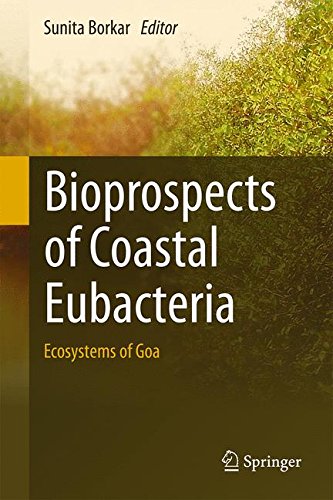
Bioprospects of Coastal Eubacteria: Ecosystems of Goa
The Eubacteria, also called just “bacteria,” are one of the three main domains of life, along with the Archaea and the Eukarya.
Eubacteria are prokaryotic, meaning their cells do not have defined, membrane-limited nuclei. As a group they display an impressive range of biochemical diversity, and their numerous members are found in every habitat on Earth.
Eubacteria are responsible for many human diseases, but also help maintain health and form vital parts of all of Earth’s ecosystems.
Eubacteria are enclosed by a cell wall. The wall is made of cross-linked chains of peptidoglycan, a polymer that combines both amino acid and sugar chains. The network structure gives the wall the strength it needs to maintain its size and shape in the face of changing chemical and osmotic differences outside the cell.
Penicillin and related antibiotics prevent bacterial cell growth by inactivating an enzyme that builds the cell wall. Penicillin-resistant bacteria contain an enzyme that chemically modifies penicillin, making it ineffective.
Bacterial cells take on one of several common shapes, which until recently were used as a basis of classification. Bacilli are rod shaped; cocci are spherical; and spirilli are spiral or wavyshaped. After division, bacterial cells may remain linked, and these form a variety of other shapes, from clusters to filaments to tight coils.
Within the Eubacteria there are species that perform virtually every biochemical reaction known (and much bacterial chemistry remains to be discovered). Most of the vitamins humans require in our diet can be synthesized by bacteria, including the vitamin K humans absorb from the Escherichia coli (E. coli ) bacteria in our large intestines.
For all organisms, extraction of energy from high-energy compounds requires a chemical reaction in which electrons move from atoms that bind them loosely to atoms that bind them tightly.
In almost all eukaryotes, the ultimate electron acceptor is oxygen, and water and carbon dioxide are the final waste products. Some bacteria use oxygen for this purpose as well. Others use sulfur (forming hydrogen sulfide, which has a strong odor), carbon (forming flammable methane, common in swamps), and a variety of other compounds.
Bacteria that use oxygen are called aerobes. Those that do not are called anaerobes. This distinction is not absolute, however, since many organisms can switch between the two modes of metabolism, and others can tolerate the presence of oxygen even if they do not use it.
Some bacteria die in oxygen, however, including members of the Gram positive Clostridium genus.
Clostridium botulinum produces botulinum toxin, the deadliest substance known.
C. tetani produces tetanus toxin, responsible for tetanus and “lockjaw,” while other Clostridium species cause gangrene.
Most eubacteria have DNA that is present in a single large circular chromosome. In addition, there may be numerous much smaller circles, called plasmids . Plasmids usually carry one or a few genes. These often are for specialized functions, such as metabolism of a particular nutrient or antibiotic.
Much of what we know about DNA replication has come from study of bacteria, particularly E. coli.
There are three types of Eubacteria: Heterotrophic, Photosynthetic autotrophs, and Chemosynthetic autotrophs.
Heterotrophic
Heterotrophic Eubacteria depend upon organic molecules to provide a source of energy. Heterotrophic Eubacteria are among the most abundant and diverse bacteria on Earth, and include bacteria that live as parasites, decomposers of organic material (saprophytes), as well as many pathogens (disease-causing bacteria).
This type of bacteria is found just about everywhere. These bacteria need organic molecules as an energy source but are not adapted for trapping the food that contains these molecules. Thus, some live as parasites, absorbing nutrients from living organisms. Others live as saprobes, organisms that feed on dead organisms or organic wastes. Saprobes help recycle the nutrients from decomposing organisms back into the environment, so those nutrients can be used for new or existing life.
Photosynthetic Autotrophs
An autotroph is an organism that can make its own food. This is done through photosynthesis, a process that uses the suns energy to make sugar molecules.
Most Cyanobacteria are blue-green in color, which is why they are often called blue-green bacteria. They are common in ponds, lakes,streams and moist areas of land. They are composed of chains of bacteria cells, an exception to the rule that Monerans are unicellular. These chains and the existence of chlorophyll (photosynthetic pigment) help provide evidence for bacteria being the ancestors of plants.
Chemosynthetic Autotrophs
The third phylum is the chemosynthetic autotrophs. These bacteria obtain their energy from chemosynthetic breakdown of inorganic (nonliving matter – no carbon) substances such as sulfur and nitrogen compounds. Some of these bacteria are important in converting nitrogen in the atmosphere to forms that can be used by plants.
If you have any information,questions, or feedback you would like to include in this webpage.
Please email momo19@naturekingdoms.com or leave your comments below.